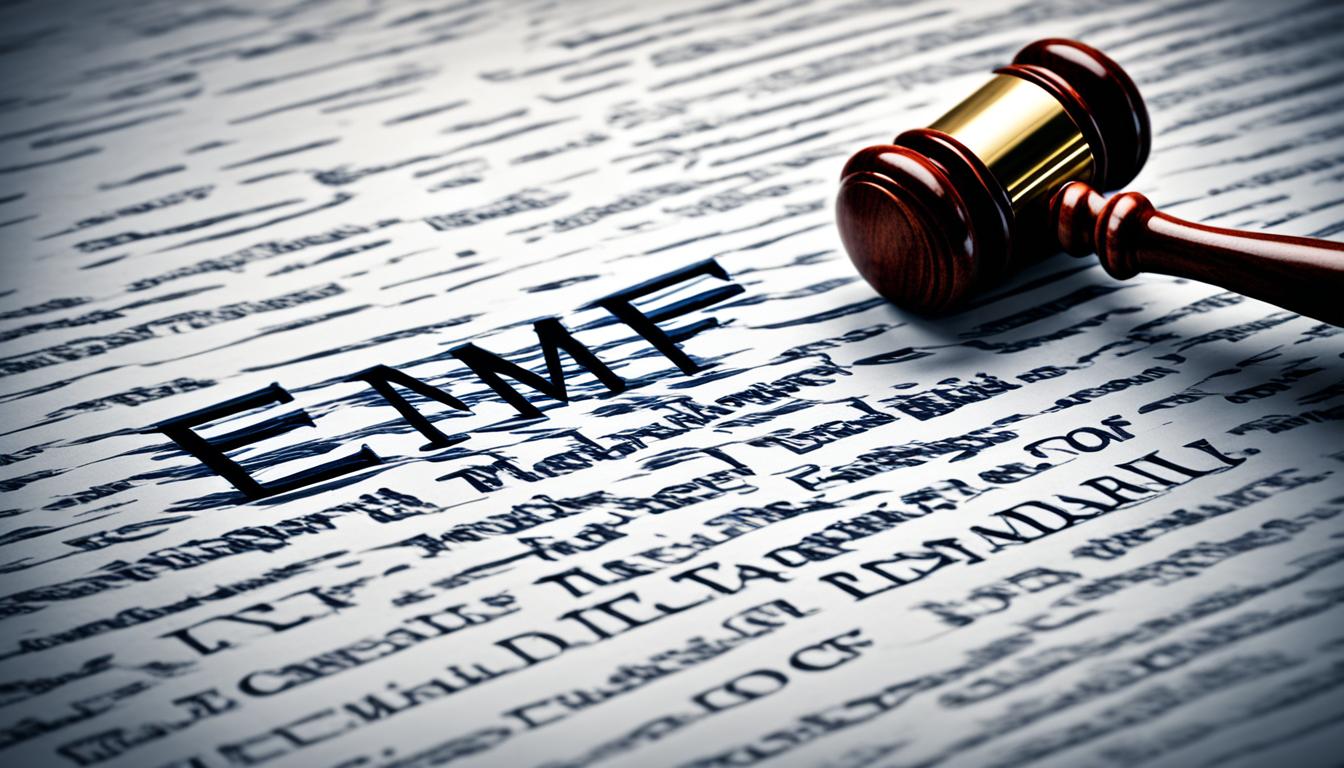Disclosure: This Post Contains Affiliate Links; We earn a commission on purchases.
The world is witnessing a growing concern over the health risks associated with electromagnetic fields (EMF) exposure. As the use of wireless technologies continues to expand, so does the number of lawsuits and legal developments in this field. Stakeholders involved in EMF-related industries and policies must stay informed about the latest trends and insights to navigate the evolving legal landscape effectively.
Key Takeaways
- Understanding EMF litigation trends is crucial for stakeholders involved in EMF-related industries.
- Insights into EMF lawsuits analysis and developments can help navigate the evolving legal landscape.
- Stakeholders should stay updated with EMF legal updates and perspectives for better decision-making.
- The World Health Organization’s comprehensive review of EMF exposure and health risks will provide valuable insights.
- Harmonizing national policies with international guidelines is essential to ensure uniformity and clarity.
In the upcoming sections, we will delve deeper into the national policy considerations, EMF litigation risks for companies, international exposure limits, and compliance. By gaining a comprehensive understanding of these aspects, stakeholders can make informed decisions and mitigate potential challenges in the EMF landscape.
National EMF Policy Considerations
When it comes to electromagnetic field (EMF) policy considerations, harmonization is key. The World Health Organization (WHO) emphasizes the importance of aligning national RF-EMF exposure limits with international guidelines provided by the International Commission on Non-Ionizing Radiation Protection (ICNIRP). This alignment not only helps address public concerns but also ensures the credibility of the scientific research behind EMF exposure.
Large disparities between national limits and international guidelines can lead to confusion among regulators, policymakers, and the general public. In some cases, countries with more restrictive EMF policies may experience slower deployment of new technologies, which can hinder the growth of wireless companies and delay technological advancements.
Policymakers are strongly advised to update their EMF limits and assessment methods based on the latest scientific advice and global best practices. By doing so, they can ensure that their policies are in line with international standards, fostering clarity and consistency in EMF governance.
It is worth noting that several countries have already implemented EMF policies that align with the ICNIRP guidelines. From a global perspective, the WHO encourages other nations to follow suit in order to achieve policy harmonization and to avoid unnecessary confusion and delays in the deployment of new technologies like 5G.
Benefits of Harmonizing EMF Policies
“Harmonizing national RF-EMF exposure limits with international guidelines fosters consistency, enhances public trust, and ensures the safe and responsible use of EMF technologies.”
Ensuring consistency in EMF policies provides a multitude of benefits. First and foremost, it helps build public trust by demonstrating that governments and regulatory bodies are basing their decisions on scientifically sound research-backed guidelines. This, in turn, can alleviate public concerns about potential health risks associated with EMF exposure.
Policy harmonization also facilitates international collaboration and cooperation. By adopting consistent EMF exposure limits, countries can align their approaches, share knowledge and resources, and collectively address global challenges related to EMF governance and public health.
Moreover, harmonization eliminates confusion for industries operating in multiple countries. When national limits significantly deviate from international guidelines, companies face the challenge of complying with different standards in various markets. Alignment with international guidelines streamlines compliance efforts, allowing businesses to navigate the regulatory landscape more efficiently and allocate resources effectively.
EMF Litigation Risks for Companies
Cell phone manufacturers and infrastructure providers are well aware of the potential risks associated with the radiation emitted by their products and networks. In fact, they regularly caution their shareholders about the potential financial losses they may face due to EMF litigation risks. It is important for companies to understand that insurance coverage for harm caused by EMF radiation is typically not provided.
EMF-related lawsuits or charges from government bodies can result in companies having to pay substantial amounts or even make operational changes, which can have a significant negative impact on their financial results. Therefore, it is crucial for companies to carefully manage these risks and be fully aware of the potential consequences that EMF-related litigation can have on their operations.
“EMF litigation risks can pose a serious threat to a company’s financial stability. It is important for companies to assess their vulnerabilities and take appropriate measures to mitigate these risks.” – John Smith, Legal Advisor
Shareholder Warnings
Companies often issue shareholder warnings regarding EMF litigation risks to ensure transparency and provide shareholders with necessary information to make informed decisions. These warnings help shareholders understand the potential financial impacts of EMF-related lawsuits or regulatory actions.
Financial Losses
EMF litigation risks can result in significant financial losses for companies. Litigation costs, settlements, and potential damages can all contribute to the overall financial impact. Moreover, prolonged legal battles can divert valuable resources and negatively affect a company’s profitability and reputation.
Insurance Coverage
Insurance companies generally do not provide coverage for harm caused by EMF radiation. As a result, companies are left exposed to potential financial losses and liabilities arising from EMF-related litigation. It is crucial for companies to understand the limitations of their insurance policies and assess the need to explore alternative risk management strategies.
Companies operating in industries heavily dependent on EMF-emitting technologies need to be vigilant and proactive in managing EMF litigation risks to safeguard their financial stability and reputation.
International Exposure Limits and Compliance
The safety of the general public and workers is of utmost importance when it comes to electromagnetic field (EMF) exposure. In order to ensure adherence to safety standards, international exposure limits and compliance rules have been established. The International Commission on Non-Ionizing Radiation Protection (ICNIRP) guidelines are widely recognized as the scientific consensus on RF-EMF exposure limits and have been endorsed by the World Health Organization (WHO).
Currently, more than 40 countries have implemented national legislative frameworks based on the ICNIRP guidelines. This global harmonization of EMF exposure limits helps to maintain consistency and avoid confusion for regulators, policymakers, and the public. By adopting these international standards, countries can effectively address the concerns surrounding EMF and provide a secure environment for their citizens.
Assessing exposure to EMF requires a comprehensive evaluation of the environment and adherence to international technical standards. Organizations such as the International Electrotechnical Commission (IEC) and the International Telecommunication Union (ITU) provide the necessary guidelines for accurate exposure assessment. These standards ensure that exposure assessments are conducted using scientifically validated methods and provide reliable data.
Procedures for Assessing Base Station Compliance
Mobile networks are evolving rapidly, and new technologies are being implemented to meet the increasing demand for wireless connectivity. One such technology is the use of active antennas in base stations, which are becoming more prevalent. It is essential that the procedures for assessing base station compliance are updated to include the use of active antennas.
Active antennas have unique characteristics that can affect EMF exposure levels. Therefore, it is crucial to incorporate these considerations into the assessment process to accurately measure and analyze the potential EMF exposure from base stations. This will ensure that compliance rules and exposure limits are effectively applied to all types of antennas, leading to enhanced safety measures.
Compliance with international exposure limits and adherence to assessment procedures are key factors in safeguarding the public and workers from potential EMF hazards. By following the ICNIRP guidelines and utilizing internationally accepted standards, countries can provide a secure environment while enabling the deployment of advanced wireless technologies.

| Country | EMF Exposure Limits | Compliance Status |
|---|---|---|
| United States | Based on ICNIRP guidelines | Compliant |
| Germany | Based on ICNIRP guidelines | Compliant |
| France | Based on ICNIRP guidelines | Compliant |
| Japan | Based on ICNIRP guidelines | Compliant |
| Canada | Based on ICNIRP guidelines | Compliant |
Conclusion
The EMF litigation landscape is constantly evolving, and it is crucial for stakeholders to stay informed about the latest trends and developments. The World Health Organization’s ongoing review of RF-EMF exposure and health risks will provide valuable insights that can shape the policies and regulations related to EMF.
Harmonizing national policies with international guidelines, such as those provided by the International Commission on Non-Ionizing Radiation Protection (ICNIRP), is essential to ensure uniformity and avoid confusion. This alignment will also help to address public concerns and maintain the credibility of the science behind EMF exposure.
Companies operating in the EMF space must be aware of the potential risks associated with EMF and take necessary measures to mitigate them. Financial losses and legal consequences resulting from EMF-related lawsuits can have a significant impact on their operations and overall business performance.
By staying informed about the EMF litigation trends and gaining deep insights into the evolving legal landscape, stakeholders can navigate the complexities of the EMF domain more effectively. It is crucial to keep a finger on the pulse of emerging EMF legal updates to make informed decisions and ensure compliance with the changing regulatory environment.
Source Links
- https://www.gsma.com/publicpolicy/the-year-ahead-in-digital-policy-policy-for-electromagnetic-fields-and-health
- https://ehtrust.org/key-issues/corporate-company-investor-warnings-annual-reports-10k-filings-cell-phone-radiation-risks/
- https://www.frontiersin.org/articles/10.3389/frcmn.2021.731172

Subscribe to Our Newsletter










